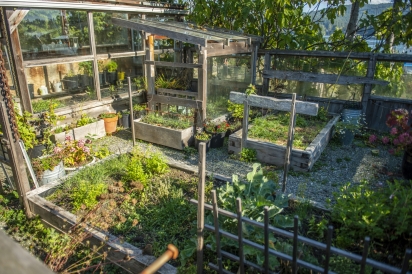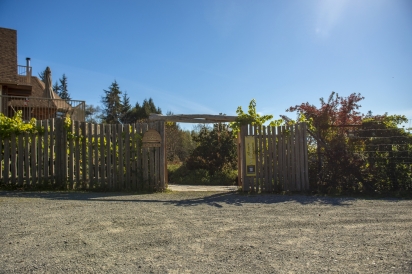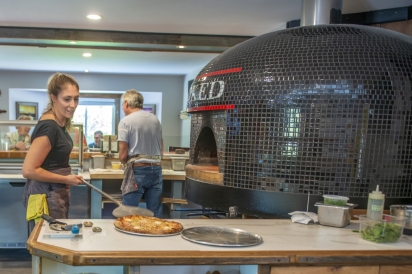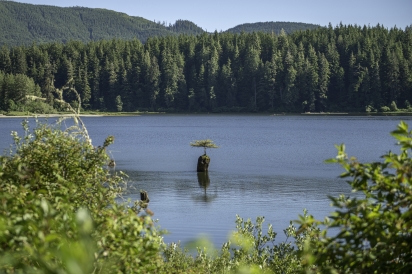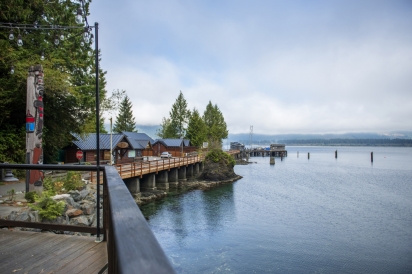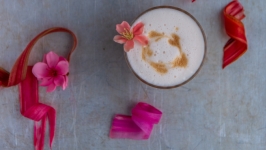The (Delicious) Road Trip from Sooke to Port Renfrew
Originally posted Winter 2018; updated Fall 2020
Just beyond the suburban sprawl of big boxes and strip malls, the road narrows and winds into the forested coastal landscape, a rugged side of the island known for its surfing beaches, tall trees and wilderness pursuits. It’s the yin to the yang of the more populous eastern shore, where sheltered waters and sunshine have long made settling more popular and practical.
And that’s the lure of the wild outer coast for me. The wetter weather and exposure to the open Pacific make this a sparsely populated place, and a bit of a renegade’s paradise.
What you’ll find on a road trip from Sooke to the “end of the road” at Port Renfrew is a reflection of that pioneering spirit, and a growing haven for food lovers, with creative craft brewers and distillers, seaside foragers, small farmers and passionate chefs.
It’s a mere 90-minute drive from the capital to a cozy cabin at Wild Renfrew and a meal at their waterside Renfrew Pub, but there’s a lot to discover en route–especially for a food lover–so making a day of the journey is more my style. It’s also the perfect way to fill the pantry with the kind of local goodies that will sustain us over a winter weekend while we explore the rainforest, in the Tall Tree Capital of Canada.
ENROUTE TO SOOKE
Highway 14 (a.k.a. Sooke Road) meanders through sprawling suburbs and farmland, teasing us with deeply wooded stretches and glimpses of the rocky coastline as we leave the city behind.
It’s all part of the 300-km Pacific Marine Circle Route, a drive that takes you out into the coastal rainforest, then cuts back across the island through its heavily logged central spine, and back to Victoria via the orchards and vineyards of the Cowichan Valley. You can drive it all easily in a day, or make it part of a longer trip, stopping to hike along rugged beaches and rainforest trails, and visiting wineries, resorts and restaurants along the way.
We’re taking the winding back roads through rural Metchosin to Sooke. It’s a chance to grab a coffee and muffin at My Chosen Café, and pick up fresh artisan bread (and some local lamb and sausages) at Nootka Rose Milling, where organic flours are milled for Fry’s and WildFire bakeries.
SOOKE STOPS
From Metchosin, it’s just a 20-minute drive to Sooke and more delicious diversions. First stop is the little roadside S.O.B. (Sooke Oceanside Brewery), tucked between a fresh produce market and a gas station, where head brewer Garritt Lalonde is busy day and night turning out his eclectic craft creations. We belly up to the thick concrete bar in the tiny tasting room for a quick flight, then fill a growler with Stiff Jab Pale Ale to enjoy later.
There’s more beer to try at Sooke Brewing Company, and we settle at a high-top table in their new tasting lounge, complete with soaring ceilings and a west coast logging theme (think live-edge tables, jagged saw blade art, and a massive cedar pole marking the entrance).
Today, the 4 Beaches Pizza food truck is on site, and hot pies are being delivered along with pints of Super Saison, a beer made with island-grown and malted barley. Both lager and ale are on the menu for tasting flights, and we leave with a couple of Crowlers (32-oz. cans) for the cooler.
Next door, famed Sooke chef Edward Tuson (an alumnus of Sooke Harbour House) has a new venture: Black Market Meats. It’s small but worth a stop for his charcuterie, whether you’re looking for smoky bacon for breakfast, fresh Thai Curry or Spicy Italian sausages for dinner, or just a picnic selection of cured meats, from salami and pastrami to air-dried beef.
 Before we leave town, there’s another tasting room to explore, this one attached to Sheringham Distillery’s new digs in Sooke. Famed for his craft spirits—kelp-infused Sheringham Seaside Gin, William’s White (white whiskey), and award-winning Akvavit—craft distiller Jason MacIsaac recently moved production from the original home distillery in Shirley. So we head over to sip spirits and learn more, all within sight of their shiny new pot and column stills.
Before we leave town, there’s another tasting room to explore, this one attached to Sheringham Distillery’s new digs in Sooke. Famed for his craft spirits—kelp-infused Sheringham Seaside Gin, William’s White (white whiskey), and award-winning Akvavit—craft distiller Jason MacIsaac recently moved production from the original home distillery in Shirley. So we head over to sip spirits and learn more, all within sight of their shiny new pot and column stills.
It’s hard to resist the cool cocktail glasses for sale alongside their other Sheringham merch, but we settle on a few bottles for gifts, and a recipe for their Akvavit Negroni.
On the return trip we’ll stop for dinner at my favourite spot in Sooke—Wild Mountain Food & Drink—where chef Oliver Kienast and his wife, sommelier and food activist Brooke Fader, bring the best of local slow food and slow fish to their ever-changing seasonal menu of homegrown, foraged and fermented culinary creations.
BEYOND SOOKE
Highway 14 (the West Coast Road) offers stunning ocean views as we head north past Otter Point to Tugwell Creek Honey Farm & Meadery, a funky family farm where they grow heritage apples, raise honey bees and offer an educational insight into their operation with a self-guided Économusée tour.
Bob Liptrot, the head beekeeper and mead maker, is behind the tasting bar, sharing his passion for bees, sustainable farming and, of course, the history of “the oldest alcoholic beverage known to man”.
“Mead was likely first created by chance occurrence during the Stone Age,” he says, explaining how the sugars in honey, combined with water and wild yeasts can spontaneously ferment to create mead. Centuries later, mead became the stuff of Nordic mythology and ancient Greek legend, with the honey wine known as the elixir of love. In fact, in medieval times, mead was essential to send off with a bride and groom for the month-long “honeymoon”.
With that in mind, we are easily smitten by his spiced Solstice Metheglin mead and berry-laced Harvest Melomel, clinking away with more bottles for the cooler.
The next stop on our radar is the busy Shirley Delicious Cafe where a crew of energetic young cooks turns out a swoon-worthy selection of sweet and savoury baked goods in a small A-frame café next to the highway. We line up and leave with a chai latte, almond croissant and a selection of monster muffins to pack along for a walk down to the historic Sheringham Point Lighthouse, where the wild waters of Juan de Fuca Strait pound the rocky shore.
SURF’S UP
There are surfing beaches all along this exposed western coastline, and we want to explore at least one along the way to Port Renfrew.
French Beach is the most accessible, with a parking lot that’s just steps away from the pebbly shore and the lull of water, waves and whale watching. But even before we get to the provincial park, we’re lured off the road by another food find — Stoked Wood Fired Pizzeria & Market. Most come for the chewy pizzas and beer, or to warm up around the flaming pizza oven while admiring the hand-hewn furniture, wrought iron and other coastal character built into this newly renovated space. But we only have time to peruse their little retail shop, admire the local art and buy some flaky Saltwest sea salt, before we’re back on the road.
At Jordan River, the conditions are perfect for windsurfing. It makes an excellent spectator sport, so we pull over at the Cold Shoulder Café, grab a cappuccino and savoury sausage roll, and pull up a log to watch the action.
The rugged Juan de Fuca Trail starts from nearby China Beach. But if you’re not up for backpacking, you can just walk to the shore or stop at Point No Point resort, with its oceanfront cabins and fine dining.
THE WILD WEST COAST
The coastal rainforest closes in as we pass the near hidden entrance to Sombrio Beach, and before long we’re pulling into Port Renfrew. Since they paved the road connecting this gritty logging town–literally at the end of the West Coast Road—with Lake Cowichan and Duncan to the east a decade ago, Renfrew has grown as a tourism destination.
It’s a result of both investment—Wild Renfrew’s development of recreational real estate, restaurants and upscale oceanside accommodations—and a burgeoning interest in the island’s last stands of giant Douglas Fir, towering Cedar, and Sitka Spruce. Beyond its fishing charters and access to the famous West Coast Trail, “tree tourism” now lures both international tourists and locals, thanks to the Ancient Forest Alliance and its efforts to protect Avatar Grove, a patch of nearby old-growth forest.
That’s at the top of my bucket list, and soon we’re bumping down a rutted logging road in search of the old giants.
In this town of 250, where many are loggers, saving trees is controversial, but the Alliance is proving that there’s an economic future in old-growth ecotourism. Now a Big Trees Map leads visitors down back roads to see towering specimens like Big Lonely Doug, a giant Douglas Fir that stands alone in a clear cut; Red Creek Fir, the enormous Harris Creek Sitka Spruce; and Canada’s Gnarliest Tree.
A small sign marks the entrance to Avatar Grove and we leave the car at the side of the road, entering the mossy world of the upper grove. Volunteers have constructed a series of chunky wooden walkways, stairs and platforms that allow visitors to access the tallest trees without destroying the fragile ecosystem around them. It’s all I can do to keep walking—my impulse is to simply stop, look way up, and bathe in the grandeur of these ancient giants, some already standing here for hundreds of years when the first European explorers set foot on this island in the late 18th century.
Wild Renfrew is working to bring this tiny town up to luxury resort standards, and we settle into a posh, woodsy cabin with every modern amenity, including a gas fire pit on the wide deck overlooking the water. The pier leads to their Renfrew Pub for an impressive dinner—the fresh tuna poke comes with cucumber, avocado and crispy wonton chips and there’s zucchini noodle Pad Thai, tender braised lamb shank with sweet potato mash, and a beautiful bouillabaisse loaded with local seafood.
Beyond the Wild Coast Cottages, built nearly a decade ago, Wild Renfrew has rejuvenated the old lodge and backpacker’s hostel, opened the seasonal Coastal Kitchen cafe, and added an Adventure Centre where you can rent bikes, kayaks, paddleboards and other outdoor gear.
It’s the classic “if you build it, they will come” story—now they’re busy running a resort and helping visitors access all of the area’s amazing wilderness. That’s why we’ve come to Port Renfrew—to slow down, unwind and smell the Sitka spruce.




